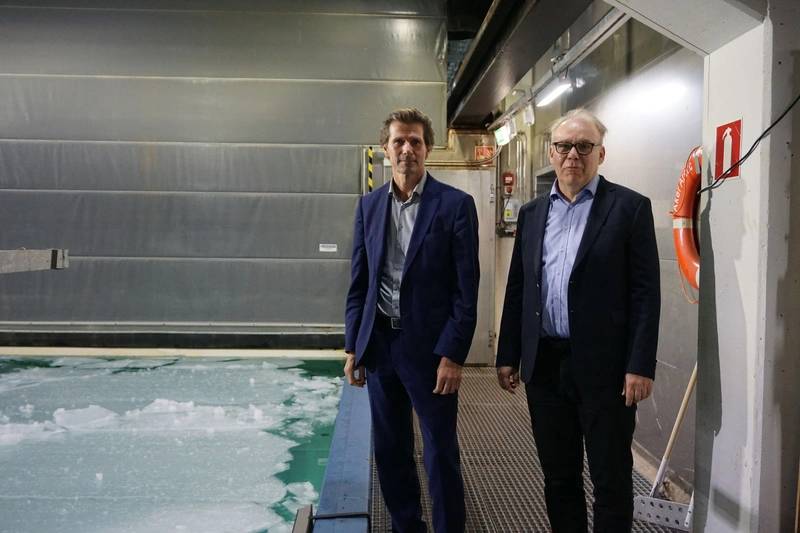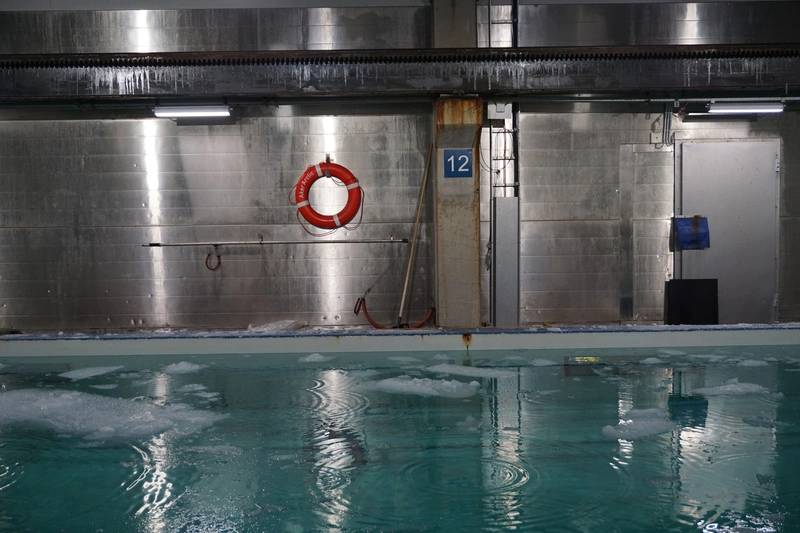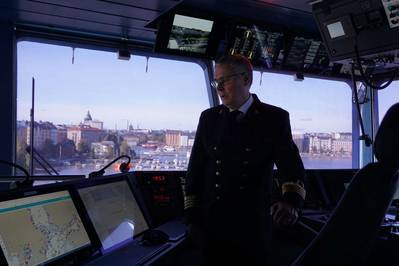FINLAND: ‘A Birthplace for Icebreakers’
Finnish companies have designed about 80 percent of the world’s icebreakers, and about 60 percent of them have been built by Finnish shipyards.
Finland is home to a strong and vibrant maritime cluster, with a mix of large, medium and small shipyards, as well as a deep pool of marine engineering expertise and a broad network of vessel equipment suppliers.
As one of the world’s northernmost countries, Finland is also home to a fleet of icebreakers that keep imports and exports flowing through its harbors, even during the coldest winter months. All Finnish ports are prone to freezing over, and the country’s icebreaking season typically starts in early December and can last through May.
It’s only natural, then, that Finland is a leading hub for icebreaking expertise. About 80% of the world’s icebreakers have been designed by Finnish companies, and some 60% of all icebreakers were built at Finnish shipyards, according to figures from Business Finland.
“Developing, designing and building icebreaking vessels is very strong in Finland,” said Reko-Antti Suojanen, managing director at Aker Arctic Technology, an engineering company specializing in icebreakers. “We hold the position as the world leader in this segment.”
Suojanen describes Aker Arctic as “a birthplace for icebreakers” because the company has provided design and engineering for the majority of the world’s icebreaking fleet.
Aker Arctic, established as an independent company in 2005, has roots that go back nearly 100 years, but today is majority owned by the Finnish government (Finnish Industry Investment, 66.4%) as well as industrial partners ABB (16.8%) and Aker Solutions (16.8%).
Aker Arctic specializes in the development, design, engineering and testing services for icebreakers and other ice-going vessels. Its experts know the ins and outs of icebreaker design and engineering, all the way down to the very last detail. “That’s part of the specialty of designing ships for ice conditions,” Suojanen said.
The company’s Helsinki headquarters houses the world’s sole privately owned ice model testing facility, complete with a 75- by 8-meter basin that allows engineers to study the performance and behavior of their designs in real ice conditions, including first and multi-year level ice, brash ice channels, ice rubble and ridges, floe ice, and first and multi-year ridges. “One of the benefits of this laboratory is that we can test new concepts and ideas,” Suojanen said.
Through the years Aker Arctic has developed a number of breakthrough innovations, such as double acting icebreakers, designed to travel forward in open water and thin ice, but turn around and proceed astern in heavy ice conditions, as well as oblique icebreakers, which operate not only ahead and astern, but also sideways to clear a larger lane through ice. Aker Arctic’s intellectual property includes 12 patented inventions in 20 countries. “Developing, designing and building icebreaking vessels is very strong in Finland,” said Reko-Antti Suojanen, managing director at Aker Arctic Technology, an engineering company specializing in icebreakers. “We hold the position as the world leader in this segment.”
“Developing, designing and building icebreaking vessels is very strong in Finland,” said Reko-Antti Suojanen, managing director at Aker Arctic Technology, an engineering company specializing in icebreakers. “We hold the position as the world leader in this segment.”
From left: Aker Arctic Technology managing director, Reko-Antti Suojanen, with director of sales and marketing, Arto Uuskallio. (Photo: Eric Haun) Aker Arctic’s Helsinki headquarters houses the world’s only privately owned ice model testing facility, used for trialing new concepts and designs in real ice conditions. (Photo: Eric Haun)
Aker Arctic’s Helsinki headquarters houses the world’s only privately owned ice model testing facility, used for trialing new concepts and designs in real ice conditions. (Photo: Eric Haun)
Future Demands and Opportunities
There are currently about 155 icebreakers in operation globally, with another 24 under construction or on order. According to Suojanen, the need for new icebreakers is growing for many reasons. One of these is the arrival of stricter emissions regulations that restrict the power of non-icebreaking vessels entering and exiting ice-encased Finnish ports, as these ships will require more icebreaking assistance.
Suojanen also sees opportunity for fleet renewal, noting that the global icebreaking fleet is aging, with nearly 50 vessels in service today that are more than 40 years old, including 13 over 50—though icebreakers are often designed and built to live longer than typical commercial vessels.
One country currently working to renew its fleet is Sweden, which engaged Aker Arctic to design a pair of new icebreakers. The project is moving toward the build phase as the Swedish Maritime Administration evaluates shipyards with the expertise and capability to build such vessels.
Notably, the ships will be the first methanol-ready and potentially the first methanol-fueled icebreakers in the world, as maritime stakeholders seek new ways to minimize their environmental footprint. Under current plans, the new icebreakers will be built initially to run on fossil-free renewable diesel oil—hydrotreated vegetable oil, (HVO) — but its engines will be ready to adapt for future methanol use as the technology matures and fuel availability is secured.
Icebreakers, like other commercial and working vessels, are candidates for other future fuels such as ammonia and hydrogen, and Aker Arctic is examining these options to help meet the International Maritime Organization’s decarbonization targets. “Icebreakers are definitely one of the most difficult [vessel types] to decarbonize because we need, first of all, a lot of power, and quite often long endurance,” Suojanen said.
But before exploring “future fuels”, it is important to improve the overall efficiency of the vessel design, Suojanen said. "You need to reduce the energy consumption,” he explained. “Then the second step is to look at which fuel to use to meet this energy requirement.”
In the case of Sweden’s new icebreakers, Aker Arctic has helped to create a more efficient hull form that is unlike any previously built. The result is an icebreaker with extremely low ice resistance for its size, reducing fuel burn—and therefore emissions and fuel cost. An onboard energy storage system (ESS) will also contribute to help slash emissions and service costs. All told, the vessels will consumer 45% less energy and emit 70% less CO2 than the 1970s-built Atle-class icebreakers serving in Sweden and Finland.
Canada is another nation in the midst of renewing its fleet of ice-capable vessels. Earlier this year, Aker Arctic completed the hull form and contributed to the concept development for Canadian Coast Guard’s 16 new multipurpose vessels slated to be built by Seaspan Shipyards. The firm is also supporting Canada’s program to build a pair of new polar icebreakers; the first vessel will be built by Seaspan Shipyards followed by the second at Davie.
Elsewhere, Aker Arctic is supporting Argentina’s program to build a new icebreaking vessel for the supply of its 13 Antarctic stations. In addition, Aker Arctic has helped to develop an ice-strengthened propulsion line for the new Pohjanmaa-class multi-role naval corvettes being built for the Finnish Navy at Rauma Marine Constructors (RMC). While not icebreakers, the naval ships will be built to withstand harsh winter conditions.
Ironically, a warming planet creates new demand for icebreakers. As the world thaws, Suojanen sees opportunities opening up in the high north. The Northwest Passage is now more accessible to vessel traffic, including cargo shipping and expedition cruising. In 2021, Ponant's Le Commandant Charcot was delivered, featuring a world-first Polar Class 2 (PC2) hull designed by Aker Arctic. The company said the vessel’s performance is comparable to existing polar icebreakers, but with lower ice resistance, ensuring better fuel economy. The double acting ship combines smooth icebreaking ahead in up to 2.5-meter-thick multiyear ice, and astern in more severe ice conditions such as heavy ice ridges.
Breaking the Ice
Finnish state-owned Arctia operates a fleet of eight vessels that provide icebreaking services for the Finnish Transport Agency during winter. All ships calling Finnish ports are required to pay fairway dues to the Finnish government, which uses the funds to help pay for Arctia’s service. The company clears frozen shipping lanes and frees any vessels that get stuck in the ice.
“We’re the only country in the world where all of the ports freeze during the winter months,” said Paavo Kojonen, Arctia’s senior vice president of icebreaking.
“When you come in wintertime with your vessel, you are supposed to proceed on your own. And when you get stuck, you get assistance to the port,” Kojonen said. “Obviously, there are limitations of what kind of vessel you can use during the wintertime.”
It is expected that cargo tonnage entering and exiting Finnish ports will increase dramatically over the coming decade, meaning greater demand for Arctia’s services, Kojonen said, noting changes to the merchant fleet as another driver. “Vessels are getting bigger, but less powerful due to environmental regulation changes.”
In the context of climate change, Kojonen said winters are trending shorter, but conditions at sea are becoming more difficult. “Climate change brings more extremes—warmer winters, but also more severe winters. It doesn’t look like it’s easing in Baltic waters in the coming decades,” he said. “There might be less ice coverage in square kilometers, but the ice is moving all about; it doesn’t freeze and stay there. The conditions, from what I hear from the captains, are getting more difficult over time.”
Arctia’s newest icebreaker, Polaris, was designed by Aker Arctic to operate in all local ice conditions. Built by Arctech Helsinki Shipyard in 2016 based up the Aker ARC 130 concept, the vessel is 110 meters long with a 24-meter beam and an 8-meter draft, allowing the vessel to operate in all major Finnish shipping lanes. The combined output of the vessel’s electrical power plant is about 22.5 megawatts (MW), making it the most powerful in the Finnish fleet. The state-of-the-art vessel features dual-fuel engines capable of using both marine diesel and liquefied natural gas (LNG), meaning it is also Arctia’s greenest.













